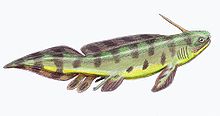Xenacanthiformes
| Xenacanthiformes | ||||||||||||
|---|---|---|---|---|---|---|---|---|---|---|---|---|

Xenacanthus decheni , reconstruction of the skeleton and outline. (From Lankester , 1909). |
||||||||||||
| Temporal occurrence | ||||||||||||
| Lower Devon to Upper Triassic | ||||||||||||
| 380 to 220 million years | ||||||||||||
| Locations | ||||||||||||
|
||||||||||||
| Systematics | ||||||||||||
|
||||||||||||
| Scientific name | ||||||||||||
| Xenacanthiformes | ||||||||||||
| Fritsch , 1889 |
The Xenacanthiformes are an extinct group of externally shark-like cartilaginous fish , which have been handed down in fossil form from the Lower Devonian to the Upper Triassic and lived in freshwater . They are therefore also referred to as "freshwater sharks". Fossils of these fish have been found in Europe , North and South America, and Australia .
features
The Xenacanthiformes showed the typical, streamlined, elongated shape of the sharks, but unlike them had a straight ( diphycerke ), long caudal fin with a fin edge of fused dorsal and anal fin. At the upper rear end of the skull was a long head spike. They had five gill arches of different lengths . In some fossil specimens there are long pair of flexible appendages close behind the pelvic fins . These are the pterygopodia or clasps, the mating or holding organs of male cartilaginous fish, which fix the female during mating until the sperm is transferred.
Systematics

- Diplodoselachidae Dick, 1981
- Xenacanthidae Fritsch, 1889
literature
- Joseph S. Nelson, Fishes of the World , John Wiley & Sons, 2006, ISBN 0-471-25031-7
